
| RESULTS |
  |
Hajdu, E., Rocha, L.A., Segal, B. & Floeter, S.R. (online). Conservation status of the southernmost reef of the Amazon Reef System: the Parcel de Manuel Luís. Coral Reefs, https://doi.org/10.1007/s00338-020-02026-1. {PDF} |
 |
https://doi.org/10.1016/j.marpolbul.2018.03.041 {PDF} |
  |
benthic communities of shallow reef habitats along the Southwestern Atlantic. PlosOne. DOI: 10.1371/journal.pone.0198452. {PDF} |
 |
ecological implications. PeerJ 6:e4777; DOI 10.7717/peerj.4777. {PDF} |
  |
2018;e12482. doi: 10.1111/maec.12482 {PDF} |
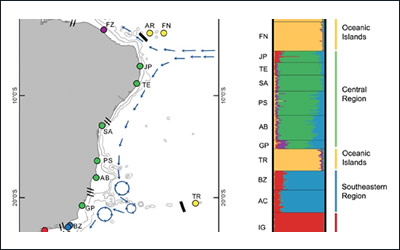  |
genetic connectivity in a Southwestern Atlantic coral. Scientific Reports, v 8, 2684. doi:10.1038/s41598-018-21010-y {PDF} |
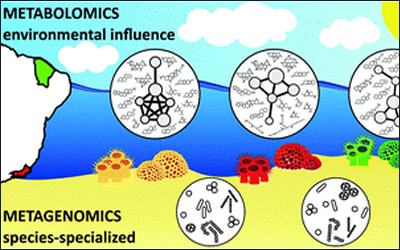  |
J.N., Lotufo, T.M.C., Pessoa, O.D.L. & Lopes, N.P. 2018. Chemical profiling of two congeneric sea mat corals along the Brazilian coast: adaptive and functional patterns. Chem. Commun. DOI: 10.1039/c7cc08411k {PDF} |
 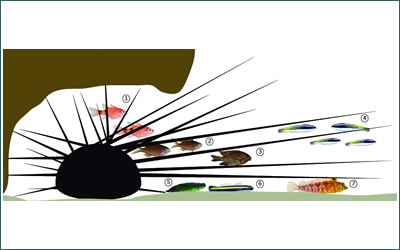 |
Atlantic oceanic island. Marine Biodiversity, 48:1833–1839. doi: 10.1007/s12526-017-0677-4. {PDF} |
  |
the only atoll in the South Atlantic. Environmental Biology of Fishes, 100: 865–875. {PDF} |
  |
|
  |
of Fish Biology, 91: 1642–1667. {PDF} | Press Release (English) | Press Release (Português) | Media |
  |
of connectivity among endemic and widespread fire coral species (Millepora spp.) in the tropical Southwestern Atlantic. Coral Reefs, 36: 701-716. DOI 10.1007/s00338-017-1562-0 {PDF} | Media |
 |
conservation zones for multiple conservation objectives in spatial prioritisation. Global Ecology and Conservation 11: 53–68. {PDF} | Press Release |
  |
J.E.; Alves-Lima, C.; Colepicolo, P.; Ameka, G.; de Graft-Johnson, K.; Gouvea, L.; Torrano-Silva, B.; Nauer, F.; Nunes, J.M.C.; Barufi, J.B.; Rorig, L.; Riosmena- Rodríguez, R.; Mello, T.J.; Lotufo, L.V.C.; Horta, P.A. 2017. The floating Sargassum (Phaeophyceae) of the South Atlantic Ocean - likely scenarios. Phycologia (Oxford): 56, 321–328; doi: 10.2216/16-92.1 {PDF} |
  |
46:547–559 DOI 10.1007/s12526-015-0396-7 {PDF} |
 |
Mussismilia hispida (Cnidaria, Scleractinia) correlate with major reef regions in the Southwestern Atlantic Ocean. Mar Biol 163:236. DOI 10.1007/s00227-016-3010-z {PDF} |
  |
island off Brazil. Marine Biodiversity. DOI 10.1007/s12526-015-0357-17 {PDF} |
  |
Silva, M.B., Ramlov, F., Gouveia, L., Ferreira, C.E.L., Segal, B., Horta, P.A. & Floeter, S.R. 2015. Between-habitat variation of benthic cover, reef fish assemblage and feeding pressure at the only atoll in South Atlantic: Rocas Atoll, NE Brazil. PLoS ONE 10(6): e0127176. doi: 10.1371/journal.pone.0127176 {PDF} | Press Release | Press Release 2 |
  |
Polyoxygenated Steroids from the Octocoral Leptogorgia punicea and in Vitro Evaluation of Their Cytotoxic Activity. Marine Drugs: 12, 5864-5880; doi:10.3390/md12125864. |
| Nos últimos três anos, pesquisas sobre a biodiversidade marinha brasileira passaram a ser realizadas, pela primeira vez, ao longo de toda a costa e de maneira integrada. Isso se deve à criação da Rede Nacional de Pesquisa em Biodiversidade Marinha (SISBIOTA-Mar) que reuniu estudos antes realizados separadamente por cada universidade, muitas vezes somente trechos restritos do litoral. A Rede envolve várias universidades brasileiras, com mais de 30 pesquisadores que passaram a planejar e executar estudos em conjunto, com reuniões periódicas para avaliar seu funcionamento. As três frentes principais são: ecologia, conectividade genética e prospecção de substâncias químicas de organismos marinhos. Apesar do pouco tempo de existência, importantes resultados já foram obtidos. Em primeiro lugar a Rede já permitiu a formação de 27 mestres, doutores e pós-doutores, com pelo menos outros 22 a seguir o mesmo caminho nos próximos dois anos. Eles permitirão multiplicar os estudos da Rede. Os pesquisadores também conseguiram “afinar” a linguagem de trabalho, resultando em trabalhos padronizados que permitem comparar os resultados até mesmo com estudos internacionais. Um exemplo disso, é que hoje sabemos que recifes isolados e/ou realmente protegidos da pesca no Brasil possuem mais peixes grandes do que locais próximos à costa e/ou desprotegidos. Outra conclusão é que alguns organismos fixos no fundo do mar produzem substâncias químicas com potencial para serem usadas como medicamentos. Algumas conseguiram, por exemplo, destruir células cancerígenas. Continuar a busca por essas substâncias promissoras, inclusive, é um dos objetivos de um projeto recentemente aprovado pela Rede e financiado pelo CNPq, o ProspecMar-Ilhas. A Rede não tem previsão para terminar. Muito pelo contrário, ela continua a todo vapor e os próximos anos devem mostrar mais avanços no conhecimento dos organismos marinhos brasileiros. |
 |
E.P.; Reginatto, F.H. & C.M.O. Simões. 2013. Anti HSV-1 Activity of Halistanol Sulfate and Halistanol Sulfate C Isolated from Brazilian Marine Sponge Petromica citrina (Demospongiae). Marine Drugs.11: 4176-4192. |
  |
determinants of geographic range size among tropical reef fishes. PNAS, 110: 16498–16502. |
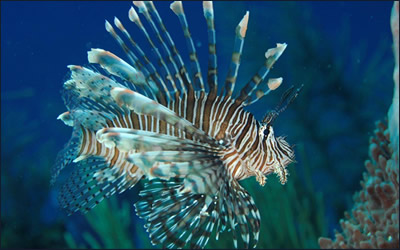 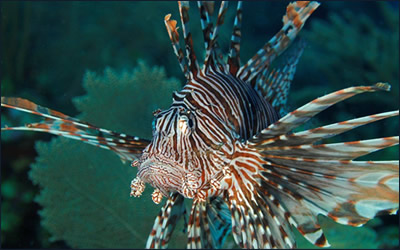 |
protected by the currents? Mar Ecol Prog Ser, 485: 1–7. |
 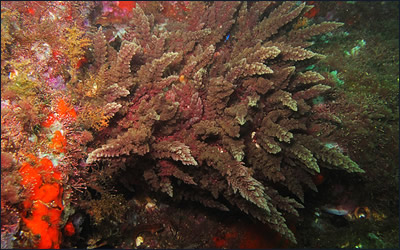 |
Martins, C.D.L.; Scherner, F.; Carraro, J.L.; Horta, P.A.; Reginatto, F.H.; Steindel, M.; Simões, C.M.O. & E.P. Schenkel. 2013. Anti-Infective Potential of Marine Invertebrates and Seaweeds from the Brazilian Coast. Molecules. 18: 5761-5778. |
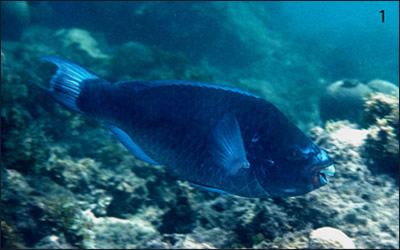 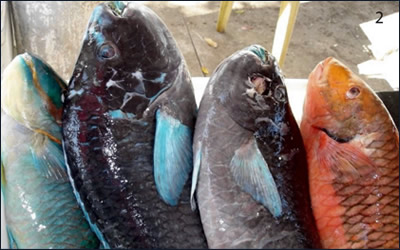 |
attributes and major threats as predictors of the vulnerability of species: a case study with Brazilian reef fishes. Oryx – The International Journal of Conservation, 47: 259–265. |
  |
Palyosulfonoceramides A and B: Unique Sulfonylated Ceramides from the Brazilian Zoanthids Palythoa caribaeorum and Protopalyhtoa variabilis. Mar. Drugs: 10, 2846-2860; doi:10.3390/md10122846 |
  |
| Quimbayo J. P., Floeter, S. R., Noguchi, R., Rangel, C. A., Gasparini, J. L., Sampaio, C. L. S., Ferreira, C. E. L. & Rocha, L. A. 2012. Cleaning mutualism in Santa Luzia (Cape Verde Archipelago) and São Tomé Islands, Tropical Eastern Atlantic. Marine Biodiversity Records, Volume 5, e118. |
 |
and rocky reefs. Journal of Fish Biology, 81: 1773–1780. |
| Este artigo descreve a metodologia de filmagem remota amplamente utilizada pelo Projeto de Ecologia da Rede Sisbiota-Mar para quantificar as interações tróficas entre peixes recifais e a comunidade bentônica. Esta técnica foi utilizada em diversas Expedições da Rede ao longo da costa brasileira. |
 |
insights on the trade-off between chemical defences and nutritional value. Marine Biodiversity Records, 5, 1–3. |
 |
  |
oceanic dispersal barriers: insights from tropical Atlantic reef fishes. Proceedings of the Royal Society of London, 279: 1033–1040. |
  |